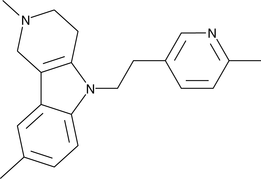Cayman
Showing 18301–18450 of 45550 results
-
Dihydrolipoic acid (DHLA) is a dithiol-containing carboxylic acid that is the reduced form of α-lipoic acid (Item No. 10005728). It acts as a general antioxidant that is highly reactive against a variety of reactive oxygen species, including hydroxyl radicals, peroxynitirite, hydrogen peroxide, and hypochlorite, at concentrations ranging from 0.01-0.5 mM.{26768} At concentrations of 50-100 µM, DHLA triggers apoptosis of mouse embryonic stem cells and human cancer cells, suppressing proliferation.{26767}
Brand:CaymanSKU:-Out of stock
Dihydrolycorine is a derivative of the alkaloid lycorine that has antihypertensive and neuroprotective activities.{45310} It inhibits methoxamine-induced contraction of isolated rabbit aortic rings and rat anococcygeus muscle with pA2 values of 5.93 and 6.35, respectively. Dihydrolycorine reduces mean arterial pressure (MAP) in anesthetized and conscious normotensive rats when administered at a dose of 80 mg/kg. It also reduces electrically or phenylephrine-induced hypertension in pithed rats. Dihydrolycorine reduces infarct size, cerebral edema, and myeloperoxidase activity in a rat model of focal cerebral ischemia-reperfusion injury when administered following reperfusion.{45311}
Brand:CaymanSKU:27809 - 1 mgAvailable on backorder
Dihydrolycorine is a derivative of the alkaloid lycorine that has antihypertensive and neuroprotective activities.{45310} It inhibits methoxamine-induced contraction of isolated rabbit aortic rings and rat anococcygeus muscle with pA2 values of 5.93 and 6.35, respectively. Dihydrolycorine reduces mean arterial pressure (MAP) in anesthetized and conscious normotensive rats when administered at a dose of 80 mg/kg. It also reduces electrically or phenylephrine-induced hypertension in pithed rats. Dihydrolycorine reduces infarct size, cerebral edema, and myeloperoxidase activity in a rat model of focal cerebral ischemia-reperfusion injury when administered following reperfusion.{45311}
Brand:CaymanSKU:27809 - 10 mgAvailable on backorder
Dihydrolycorine is a derivative of the alkaloid lycorine that has antihypertensive and neuroprotective activities.{45310} It inhibits methoxamine-induced contraction of isolated rabbit aortic rings and rat anococcygeus muscle with pA2 values of 5.93 and 6.35, respectively. Dihydrolycorine reduces mean arterial pressure (MAP) in anesthetized and conscious normotensive rats when administered at a dose of 80 mg/kg. It also reduces electrically or phenylephrine-induced hypertension in pithed rats. Dihydrolycorine reduces infarct size, cerebral edema, and myeloperoxidase activity in a rat model of focal cerebral ischemia-reperfusion injury when administered following reperfusion.{45311}
Brand:CaymanSKU:27809 - 25 mgAvailable on backorder
Dihydrolycorine is a derivative of the alkaloid lycorine that has antihypertensive and neuroprotective activities.{45310} It inhibits methoxamine-induced contraction of isolated rabbit aortic rings and rat anococcygeus muscle with pA2 values of 5.93 and 6.35, respectively. Dihydrolycorine reduces mean arterial pressure (MAP) in anesthetized and conscious normotensive rats when administered at a dose of 80 mg/kg. It also reduces electrically or phenylephrine-induced hypertension in pithed rats. Dihydrolycorine reduces infarct size, cerebral edema, and myeloperoxidase activity in a rat model of focal cerebral ischemia-reperfusion injury when administered following reperfusion.{45311}
Brand:CaymanSKU:27809 - 5 mgAvailable on backorder
Dihydromethysticin is a kavalactone originally isolated from P. methysticum (kava-kava) that has diverse biological activities, including efflux transporter inhibitory, antinociceptive, and neuroprotective properties.{42940,42941} Dihydromethysticin is a P-glycoprotein (P-gp) inhibitor that increases uptake of the P-gp substrate calcein AM (Item No. 14948) by 50% in P388 mouse leukemia cancer cells overexpressing P-gp when used at a concentration of 54.6 μM.{42942} Dihydromethysticin (275 mg/kg) has analgesic activity, increasing the latency to tail withdrawal in the tail-flick assay in mice.{42940} It also decreases the infarct size in a mouse model of ischemia induced by microbipolar coagulation of the left middle cerebral artery (MCA) when administered at a dose of 10 mg/kg.{42941}
Brand:CaymanSKU:27644 - 5 mgAvailable on backorder
Dihydromyricetin is a natural flavanonol isolated from A. grossedentata, H. dulcis, and other plants that has antioxidant, antiproliferative, anti-apoptotic, and anti-alcohol intoxication properties.{36503,36504,36505,36506,36507,36508} Dihydromyricetin scavenges 1,1-diphenyl-2-picrylhydrazyl (DPPH) radicals (IC50 = 0.235 μg/ml) and decreases reactive oxygen species (ROS) generated by AAPH (Item No. 82235) in human erythrocytes when used at a concentration of 6 μg/ml.{36505} It dose-dependently decreases proliferation and increases apoptosis in human liver carcinoma HepG2 cells, but does not affect proliferation of normal hepatic HL7702 cells.{36506} In vivo, it decreases tumor volume by 43.5% in a HepG2 mouse xenograft model when administered at a dose of 500 mg/kg per day.{36507} Dihydromyricetin binds to GABAA receptors in rat cortical membrane reparations (IC50 = 4.36 μM) and dose-dependently reduces loss of righting reflex (LORR) in ethanol-intoxicated rats.{36508} It also improves cognitive deficits in a mouse model of Alzheimer’s disease when administered at 2 mg/kg for three months.{36509}
Brand:CaymanSKU:23549 - 10 mgAvailable on backorder
Dihydromyricetin is a natural flavanonol isolated from A. grossedentata, H. dulcis, and other plants that has antioxidant, antiproliferative, anti-apoptotic, and anti-alcohol intoxication properties.{36503,36504,36505,36506,36507,36508} Dihydromyricetin scavenges 1,1-diphenyl-2-picrylhydrazyl (DPPH) radicals (IC50 = 0.235 μg/ml) and decreases reactive oxygen species (ROS) generated by AAPH (Item No. 82235) in human erythrocytes when used at a concentration of 6 μg/ml.{36505} It dose-dependently decreases proliferation and increases apoptosis in human liver carcinoma HepG2 cells, but does not affect proliferation of normal hepatic HL7702 cells.{36506} In vivo, it decreases tumor volume by 43.5% in a HepG2 mouse xenograft model when administered at a dose of 500 mg/kg per day.{36507} Dihydromyricetin binds to GABAA receptors in rat cortical membrane reparations (IC50 = 4.36 μM) and dose-dependently reduces loss of righting reflex (LORR) in ethanol-intoxicated rats.{36508} It also improves cognitive deficits in a mouse model of Alzheimer’s disease when administered at 2 mg/kg for three months.{36509}
Brand:CaymanSKU:23549 - 25 mgAvailable on backorder
Dihydromyricetin is a natural flavanonol isolated from A. grossedentata, H. dulcis, and other plants that has antioxidant, antiproliferative, anti-apoptotic, and anti-alcohol intoxication properties.{36503,36504,36505,36506,36507,36508} Dihydromyricetin scavenges 1,1-diphenyl-2-picrylhydrazyl (DPPH) radicals (IC50 = 0.235 μg/ml) and decreases reactive oxygen species (ROS) generated by AAPH (Item No. 82235) in human erythrocytes when used at a concentration of 6 μg/ml.{36505} It dose-dependently decreases proliferation and increases apoptosis in human liver carcinoma HepG2 cells, but does not affect proliferation of normal hepatic HL7702 cells.{36506} In vivo, it decreases tumor volume by 43.5% in a HepG2 mouse xenograft model when administered at a dose of 500 mg/kg per day.{36507} Dihydromyricetin binds to GABAA receptors in rat cortical membrane reparations (IC50 = 4.36 μM) and dose-dependently reduces loss of righting reflex (LORR) in ethanol-intoxicated rats.{36508} It also improves cognitive deficits in a mouse model of Alzheimer’s disease when administered at 2 mg/kg for three months.{36509}
Brand:CaymanSKU:23549 - 5 mgAvailable on backorder
Dihydromyricetin is a natural flavanonol isolated from A. grossedentata, H. dulcis, and other plants that has antioxidant, antiproliferative, anti-apoptotic, and anti-alcohol intoxication properties.{36503,36504,36505,36506,36507,36508} Dihydromyricetin scavenges 1,1-diphenyl-2-picrylhydrazyl (DPPH) radicals (IC50 = 0.235 μg/ml) and decreases reactive oxygen species (ROS) generated by AAPH (Item No. 82235) in human erythrocytes when used at a concentration of 6 μg/ml.{36505} It dose-dependently decreases proliferation and increases apoptosis in human liver carcinoma HepG2 cells, but does not affect proliferation of normal hepatic HL7702 cells.{36506} In vivo, it decreases tumor volume by 43.5% in a HepG2 mouse xenograft model when administered at a dose of 500 mg/kg per day.{36507} Dihydromyricetin binds to GABAA receptors in rat cortical membrane reparations (IC50 = 4.36 μM) and dose-dependently reduces loss of righting reflex (LORR) in ethanol-intoxicated rats.{36508} It also improves cognitive deficits in a mouse model of Alzheimer’s disease when administered at 2 mg/kg for three months.{36509}
Brand:CaymanSKU:23549 - 50 mgAvailable on backorder
Dihydronovobiocin is a coumarin antibiotic and derivative of novobiocin (Item No. 18457).{49480} It is active against the bacteria S. aureus, S. haemolyticus, D. pneumoniae, S. typhosa, K. pneumoniae, and P. multocida (MICs = 0.6, 2, 0.6, 10, 10, and 3 µg/ml, respectively).{49481} Dihydronovobiocin inhibits DNA gyrase subunit B with an IC50 value of 64.5 nM.{49482}
Brand:CaymanSKU:29649 - 1 mgAvailable on backorder
Dihydronovobiocin is a coumarin antibiotic and derivative of novobiocin (Item No. 18457).{49480} It is active against the bacteria S. aureus, S. haemolyticus, D. pneumoniae, S. typhosa, K. pneumoniae, and P. multocida (MICs = 0.6, 2, 0.6, 10, 10, and 3 µg/ml, respectively).{49481} Dihydronovobiocin inhibits DNA gyrase subunit B with an IC50 value of 64.5 nM.{49482}
Brand:CaymanSKU:29649 - 5 mgAvailable on backorder
Dihydrophytol is an intermediate in the biosynthesis of phytanic acid (Item No. 90360).{53994} It is produced from phytol (Item No. 17401) in the rumen of cattle.{53995}
Brand:CaymanSKU:31692 - 1 gAvailable on backorder
Dihydrophytol is an intermediate in the biosynthesis of phytanic acid (Item No. 90360).{53994} It is produced from phytol (Item No. 17401) in the rumen of cattle.{53995}
Brand:CaymanSKU:31692 - 100 mgAvailable on backorder
Dihydrophytol is an intermediate in the biosynthesis of phytanic acid (Item No. 90360).{53994} It is produced from phytol (Item No. 17401) in the rumen of cattle.{53995}
Brand:CaymanSKU:31692 - 500 mgAvailable on backorder
Dihydropleuromutilin is a semisynthetic antibiotic and derivative of pleuromutilin (Item No. 19452).{42573} It is active against S. aureus, M. hominis, M. gallisepticum, and M. hyorhinis bacteria (MICs = 0.5, 0.3, 0.3, and 2 µg/ml, respectively).
Brand:CaymanSKU:26497 - 25 mgAvailable on backorder
Dihydropleuromutilin is a semisynthetic antibiotic and derivative of pleuromutilin (Item No. 19452).{42573} It is active against S. aureus, M. hominis, M. gallisepticum, and M. hyorhinis bacteria (MICs = 0.5, 0.3, 0.3, and 2 µg/ml, respectively).
Brand:CaymanSKU:26497 - 5 mgAvailable on backorder
Dihydroresveratrol is a major metabolite of resveratrol (Item Nos. 70675 and 10004235) that is produced by animal-associated bacteria, including the gut microbiota.{31381,31380} Dihydroresveratrol and dihydroresveratrol monosulfate are detectable in urine.{31382} The physiological effects of dihydroresveratrol have not been investigated.
Brand:CaymanSKU:19651 -Available on backorder
Dihydroresveratrol is a major metabolite of resveratrol (Item Nos. 70675 and 10004235) that is produced by animal-associated bacteria, including the gut microbiota.{31381,31380} Dihydroresveratrol and dihydroresveratrol monosulfate are detectable in urine.{31382} The physiological effects of dihydroresveratrol have not been investigated.
Brand:CaymanSKU:19651 -Available on backorder
Dihydroresveratrol is a major metabolite of resveratrol (Item Nos. 70675 and 10004235) that is produced by animal-associated bacteria, including the gut microbiota.{31381,31380} Dihydroresveratrol and dihydroresveratrol monosulfate are detectable in urine.{31382} The physiological effects of dihydroresveratrol have not been investigated.
Brand:CaymanSKU:19651 -Available on backorder
Dihydroresveratrol is a major metabolite of resveratrol (Item Nos. 70675 and 10004235) that is produced by animal-associated bacteria, including the gut microbiota.{31381,31380} Dihydroresveratrol and dihydroresveratrol monosulfate are detectable in urine.{31382} The physiological effects of dihydroresveratrol have not been investigated.
Brand:CaymanSKU:19651 -Available on backorder
DHR is a cell-permeable fluorogenic probe that is used as an indicator of intracellular peroxynitrite formation.{6533} It is oxidized by peroxynitrite to the highly fluorescent product rhodamine in vitro. Neither nitric oxide, superoxide, nor hydrogen peroxide alone appear to oxidize DHR.{6533} Formation of rhodamine can be monitored by fluorescence spectroscopy using excitation and emission wavelengths of 500 and 536 nm, respectively, or by absorbance spectroscopy at 500 nm (ε = 78,800 M−1cm−1).{3676,5114,6533} DHR has been used to investigate reactive oxygen intermediates produced by endothelial cells, eosinophils, and reactive microglia.{19222,19223,19221}
Brand:CaymanSKU:85100 - 1 mgAvailable on backorder
DHR is a cell-permeable fluorogenic probe that is used as an indicator of intracellular peroxynitrite formation.{6533} It is oxidized by peroxynitrite to the highly fluorescent product rhodamine in vitro. Neither nitric oxide, superoxide, nor hydrogen peroxide alone appear to oxidize DHR.{6533} Formation of rhodamine can be monitored by fluorescence spectroscopy using excitation and emission wavelengths of 500 and 536 nm, respectively, or by absorbance spectroscopy at 500 nm (ε = 78,800 M−1cm−1).{3676,5114,6533} DHR has been used to investigate reactive oxygen intermediates produced by endothelial cells, eosinophils, and reactive microglia.{19222,19223,19221}
Brand:CaymanSKU:85100 - 10 mgAvailable on backorder
DHR is a cell-permeable fluorogenic probe that is used as an indicator of intracellular peroxynitrite formation.{6533} It is oxidized by peroxynitrite to the highly fluorescent product rhodamine in vitro. Neither nitric oxide, superoxide, nor hydrogen peroxide alone appear to oxidize DHR.{6533} Formation of rhodamine can be monitored by fluorescence spectroscopy using excitation and emission wavelengths of 500 and 536 nm, respectively, or by absorbance spectroscopy at 500 nm (ε = 78,800 M−1cm−1).{3676,5114,6533} DHR has been used to investigate reactive oxygen intermediates produced by endothelial cells, eosinophils, and reactive microglia.{19222,19223,19221}
Brand:CaymanSKU:85100 - 25 mgAvailable on backorder
DHR is a cell-permeable fluorogenic probe that is used as an indicator of intracellular peroxynitrite formation.{6533} It is oxidized by peroxynitrite to the highly fluorescent product rhodamine in vitro. Neither nitric oxide, superoxide, nor hydrogen peroxide alone appear to oxidize DHR.{6533} Formation of rhodamine can be monitored by fluorescence spectroscopy using excitation and emission wavelengths of 500 and 536 nm, respectively, or by absorbance spectroscopy at 500 nm (ε = 78,800 M−1cm−1).{3676,5114,6533} DHR has been used to investigate reactive oxygen intermediates produced by endothelial cells, eosinophils, and reactive microglia.{19222,19223,19221}
Brand:CaymanSKU:85100 - 5 mgAvailable on backorder
Dihydrosanguinarine is an alkaloid and a metabolite of the alkaloid sanguinarine (Item No. 16951) that has diverse biological activities, including anticancer, fungicidal, and antiprotozoal properties.{54383,54384,54385} It inhibits proliferation of PANC-1, SW 1990, and HPDE6c7 cancer cells when used at concentrations of 10, 20, and 30 µM.{54383} It also reduces the levels of phosphorylated ERK and C-RAF, halts the cell cycle at the G0/G1 and G2/M phases, and induces apoptosis in PANC-1 cells. Dihydrosanguinarine inhibits spore germination of the phytopathogenic fungi B. cinerea and E. graminis in vitro (EC50s = 56.35 and 95.75 µg/ml, respectively).{54384} It has protective and curative effects against B. cinerea and E. graminis when applied as a spray to plants either before or after infection, respectively, at concentrations of 100 and 500 µg/ml. Dihydrosanguinarine is also effective against I. multifiliis infestation in S. curriculus (EC50 = 5.18 mg/L) with an LC50 value of 13.3 mg/L.{54385}
Brand:CaymanSKU:31139 - 1 mgAvailable on backorder
Dihydrosanguinarine is an alkaloid and a metabolite of the alkaloid sanguinarine (Item No. 16951) that has diverse biological activities, including anticancer, fungicidal, and antiprotozoal properties.{54383,54384,54385} It inhibits proliferation of PANC-1, SW 1990, and HPDE6c7 cancer cells when used at concentrations of 10, 20, and 30 µM.{54383} It also reduces the levels of phosphorylated ERK and C-RAF, halts the cell cycle at the G0/G1 and G2/M phases, and induces apoptosis in PANC-1 cells. Dihydrosanguinarine inhibits spore germination of the phytopathogenic fungi B. cinerea and E. graminis in vitro (EC50s = 56.35 and 95.75 µg/ml, respectively).{54384} It has protective and curative effects against B. cinerea and E. graminis when applied as a spray to plants either before or after infection, respectively, at concentrations of 100 and 500 µg/ml. Dihydrosanguinarine is also effective against I. multifiliis infestation in S. curriculus (EC50 = 5.18 mg/L) with an LC50 value of 13.3 mg/L.{54385}
Brand:CaymanSKU:31139 - 10 mgAvailable on backorder
Dihydrosanguinarine is an alkaloid and a metabolite of the alkaloid sanguinarine (Item No. 16951) that has diverse biological activities, including anticancer, fungicidal, and antiprotozoal properties.{54383,54384,54385} It inhibits proliferation of PANC-1, SW 1990, and HPDE6c7 cancer cells when used at concentrations of 10, 20, and 30 µM.{54383} It also reduces the levels of phosphorylated ERK and C-RAF, halts the cell cycle at the G0/G1 and G2/M phases, and induces apoptosis in PANC-1 cells. Dihydrosanguinarine inhibits spore germination of the phytopathogenic fungi B. cinerea and E. graminis in vitro (EC50s = 56.35 and 95.75 µg/ml, respectively).{54384} It has protective and curative effects against B. cinerea and E. graminis when applied as a spray to plants either before or after infection, respectively, at concentrations of 100 and 500 µg/ml. Dihydrosanguinarine is also effective against I. multifiliis infestation in S. curriculus (EC50 = 5.18 mg/L) with an LC50 value of 13.3 mg/L.{54385}
Brand:CaymanSKU:31139 - 25 mgAvailable on backorder
Dihydrosanguinarine is an alkaloid and a metabolite of the alkaloid sanguinarine (Item No. 16951) that has diverse biological activities, including anticancer, fungicidal, and antiprotozoal properties.{54383,54384,54385} It inhibits proliferation of PANC-1, SW 1990, and HPDE6c7 cancer cells when used at concentrations of 10, 20, and 30 µM.{54383} It also reduces the levels of phosphorylated ERK and C-RAF, halts the cell cycle at the G0/G1 and G2/M phases, and induces apoptosis in PANC-1 cells. Dihydrosanguinarine inhibits spore germination of the phytopathogenic fungi B. cinerea and E. graminis in vitro (EC50s = 56.35 and 95.75 µg/ml, respectively).{54384} It has protective and curative effects against B. cinerea and E. graminis when applied as a spray to plants either before or after infection, respectively, at concentrations of 100 and 500 µg/ml. Dihydrosanguinarine is also effective against I. multifiliis infestation in S. curriculus (EC50 = 5.18 mg/L) with an LC50 value of 13.3 mg/L.{54385}
Brand:CaymanSKU:31139 - 5 mgAvailable on backorder
Dihydrospinosyn A aglycone is a derivative of spinosyn A aglycone with a reduced double bond at positions 5 and 6.
Brand:CaymanSKU:23641 - 2.5 mgAvailable on backorder
Dihydrospinosyn A aglycone is a derivative of spinosyn A aglycone with a reduced double bond at positions 5 and 6.
Brand:CaymanSKU:23641 - 500 µgAvailable on backorder
Dihydrostreptomycin is an aminoglycoside antibiotic and a derivative of streptomycin (Item No. 21211).{47596} It is active against B. subtilis, K. pneumoniae, S. marcescens, S. aureus, P. aeruginosa, and M. tuberculosis (MICs = 0.07, 0.08, 0.09, 0.06, 0.8, and 5.7 µg/ml, respectively). It interferes with bacterial protein synthesis by binding the 30S ribosomal subunit.{47595} Dihydrostreptomycin enhances phagocytosis and intracellular killing of E. coli by isolated mouse peritoneal macrophages.{47597} It improves survival in a mouse model of S. aureus infection.{47598} Formulations containing dihydrostreptomycin have been used in the prevention and treatment of bacterial infections in livestock.
Brand:CaymanSKU:27879 - 100 gAvailable on backorder
Dihydrostreptomycin is an aminoglycoside antibiotic and a derivative of streptomycin (Item No. 21211).{47596} It is active against B. subtilis, K. pneumoniae, S. marcescens, S. aureus, P. aeruginosa, and M. tuberculosis (MICs = 0.07, 0.08, 0.09, 0.06, 0.8, and 5.7 µg/ml, respectively). It interferes with bacterial protein synthesis by binding the 30S ribosomal subunit.{47595} Dihydrostreptomycin enhances phagocytosis and intracellular killing of E. coli by isolated mouse peritoneal macrophages.{47597} It improves survival in a mouse model of S. aureus infection.{47598} Formulations containing dihydrostreptomycin have been used in the prevention and treatment of bacterial infections in livestock.
Brand:CaymanSKU:27879 - 250 gAvailable on backorder
Dihydrostreptomycin is an aminoglycoside antibiotic and a derivative of streptomycin (Item No. 21211).{47596} It is active against B. subtilis, K. pneumoniae, S. marcescens, S. aureus, P. aeruginosa, and M. tuberculosis (MICs = 0.07, 0.08, 0.09, 0.06, 0.8, and 5.7 µg/ml, respectively). It interferes with bacterial protein synthesis by binding the 30S ribosomal subunit.{47595} Dihydrostreptomycin enhances phagocytosis and intracellular killing of E. coli by isolated mouse peritoneal macrophages.{47597} It improves survival in a mouse model of S. aureus infection.{47598} Formulations containing dihydrostreptomycin have been used in the prevention and treatment of bacterial infections in livestock.
Brand:CaymanSKU:27879 - 50 gAvailable on backorder
Dihydrostreptomycin is an aminoglycoside antibiotic and a derivative of streptomycin (Item No. 21211).{47596} It is active against B. subtilis, K. pneumoniae, S. marcescens, S. aureus, P. aeruginosa, and M. tuberculosis (MICs = 0.07, 0.08, 0.09, 0.06, 0.8, and 5.7 µg/ml, respectively). It interferes with bacterial protein synthesis by binding the 30S ribosomal subunit.{47595} Dihydrostreptomycin enhances phagocytosis and intracellular killing of E. coli by isolated mouse peritoneal macrophages.{47597} It improves survival in a mouse model of S. aureus infection.{47598} Formulations containing dihydrostreptomycin have been used in the prevention and treatment of bacterial infections in livestock.
Brand:CaymanSKU:27879 - 500 gAvailable on backorder
Dihydrotetrabenazine is an active metabolite of the vesicular monoamine transporter 2 (VMAT2) inhibitor tetrabenazine (Item No. 20380) that is generated by hepatic carbonyl reductases.{46154} Dihydrotetrabenazine binds to mouse pons medulla, hypothalamus, and striatum (Kds = 2.72, 2.28, and 2.4 nM, respectively) and inhibits synaptic vesicular serotonin (5-HT) uptake (IC50s = 2.2, 2.8, and 2.3 nM, respectively).{46156} It also binds to human caudate nucleus, hippocampus, and substantia nigra pars compacta (Kds = 2.9, 2.5, and 2.8 nM, respectively).{46157} Dihydrotetrabenazine stereoisomers bind to VMAT2 in rat striatum.{46155}
Brand:CaymanSKU:27182 - 1 mgAvailable on backorder
Dihydrotetrabenazine is an active metabolite of the vesicular monoamine transporter 2 (VMAT2) inhibitor tetrabenazine (Item No. 20380) that is generated by hepatic carbonyl reductases.{46154} Dihydrotetrabenazine binds to mouse pons medulla, hypothalamus, and striatum (Kds = 2.72, 2.28, and 2.4 nM, respectively) and inhibits synaptic vesicular serotonin (5-HT) uptake (IC50s = 2.2, 2.8, and 2.3 nM, respectively).{46156} It also binds to human caudate nucleus, hippocampus, and substantia nigra pars compacta (Kds = 2.9, 2.5, and 2.8 nM, respectively).{46157} Dihydrotetrabenazine stereoisomers bind to VMAT2 in rat striatum.{46155}
Brand:CaymanSKU:27182 - 500 µgAvailable on backorder
Dihydrotetrodecamycin is a fungal metabolite originally isolated from S. nashvillensis that has antibacterial activity.{49633,49634} It is active against the piscine pathogenic bacterium P. piscicida.
Brand:CaymanSKU:29725 - 1 mgAvailable on backorder
Dihydroxy melphalan is an inactive degradation product of melphalan (Item No. 16665).{46221,46223} It is formed by the hydrolysis of melphalan via the intermediate monohydroxy melphalan (Item No. 27856) in aqueous solutions, including cell culture medium and human plasma.
Brand:CaymanSKU:27857 - 1 mgAvailable on backorder
Dihydroxy melphalan is an inactive degradation product of melphalan (Item No. 16665).{46221,46223} It is formed by the hydrolysis of melphalan via the intermediate monohydroxy melphalan (Item No. 27856) in aqueous solutions, including cell culture medium and human plasma.
Brand:CaymanSKU:27857 - 10 mgAvailable on backorder
Dihydroxy melphalan is an inactive degradation product of melphalan (Item No. 16665).{46221,46223} It is formed by the hydrolysis of melphalan via the intermediate monohydroxy melphalan (Item No. 27856) in aqueous solutions, including cell culture medium and human plasma.
Brand:CaymanSKU:27857 - 25 mgAvailable on backorder
Dihydroxy melphalan is an inactive degradation product of melphalan (Item No. 16665).{46221,46223} It is formed by the hydrolysis of melphalan via the intermediate monohydroxy melphalan (Item No. 27856) in aqueous solutions, including cell culture medium and human plasma.
Brand:CaymanSKU:27857 - 5 mgAvailable on backorder
DiIC1(5) is a signal-off fluorescent probe for the detection of mitochondrial membrane potential disruption.{46228,46229} It accumulates in mitochondria and its fluorescence intensity decreases when the mitochondrial membrane potential is disrupted. DilC1(5) has been used in combination with a variety of cell damage and cell death markers to classify nine stages of cell death using flow cytometry.{46230} It has also been used as a quencher for the detection of serine phosphorylation and tyrosine dephosphorylation post-translational modifications (PTMs) in quenching resonance energy transfer (QRET) and mTR-FRET applications.{46229} It displays excitation/emission maxima of 659/666 nm, respectively.
Brand:CaymanSKU:26861 - 100 mgAvailable on backorder
DiIC1(5) is a signal-off fluorescent probe for the detection of mitochondrial membrane potential disruption.{46228,46229} It accumulates in mitochondria and its fluorescence intensity decreases when the mitochondrial membrane potential is disrupted. DilC1(5) has been used in combination with a variety of cell damage and cell death markers to classify nine stages of cell death using flow cytometry.{46230} It has also been used as a quencher for the detection of serine phosphorylation and tyrosine dephosphorylation post-translational modifications (PTMs) in quenching resonance energy transfer (QRET) and mTR-FRET applications.{46229} It displays excitation/emission maxima of 659/666 nm, respectively.
Brand:CaymanSKU:26861 - 25 mgAvailable on backorder
DiIC1(5) is a signal-off fluorescent probe for the detection of mitochondrial membrane potential disruption.{46228,46229} It accumulates in mitochondria and its fluorescence intensity decreases when the mitochondrial membrane potential is disrupted. DilC1(5) has been used in combination with a variety of cell damage and cell death markers to classify nine stages of cell death using flow cytometry.{46230} It has also been used as a quencher for the detection of serine phosphorylation and tyrosine dephosphorylation post-translational modifications (PTMs) in quenching resonance energy transfer (QRET) and mTR-FRET applications.{46229} It displays excitation/emission maxima of 659/666 nm, respectively.
Brand:CaymanSKU:26861 - 250 mgAvailable on backorder
DiIC1(5) is a signal-off fluorescent probe for the detection of mitochondrial membrane potential disruption.{46228,46229} It accumulates in mitochondria and its fluorescence intensity decreases when the mitochondrial membrane potential is disrupted. DilC1(5) has been used in combination with a variety of cell damage and cell death markers to classify nine stages of cell death using flow cytometry.{46230} It has also been used as a quencher for the detection of serine phosphorylation and tyrosine dephosphorylation post-translational modifications (PTMs) in quenching resonance energy transfer (QRET) and mTR-FRET applications.{46229} It displays excitation/emission maxima of 659/666 nm, respectively.
Brand:CaymanSKU:26861 - 50 mgAvailable on backorder
Dil is a fluorescent neuronal tracer that labels cell bodies, axons, dendrites, and dendritic spines.{49650} It has been used as an anterograde tracer to study neuronal development in vivo and as a retrograde tracer to label hippocampal neuronal connections in fixed postmortem brain tissue.{49650,49646} Dil has also been used as a long-term plasma membrane label in live cells.{49646} It displays excitation/emission maxima of 549/565 nm, respectively.{49647}
Brand:CaymanSKU:30423 - 10 mgAvailable on backorder
Dil is a fluorescent neuronal tracer that labels cell bodies, axons, dendrites, and dendritic spines.{49650} It has been used as an anterograde tracer to study neuronal development in vivo and as a retrograde tracer to label hippocampal neuronal connections in fixed postmortem brain tissue.{49650,49646} Dil has also been used as a long-term plasma membrane label in live cells.{49646} It displays excitation/emission maxima of 549/565 nm, respectively.{49647}
Brand:CaymanSKU:30423 - 100 mgAvailable on backorder
Dil is a fluorescent neuronal tracer that labels cell bodies, axons, dendrites, and dendritic spines.{49650} It has been used as an anterograde tracer to study neuronal development in vivo and as a retrograde tracer to label hippocampal neuronal connections in fixed postmortem brain tissue.{49650,49646} Dil has also been used as a long-term plasma membrane label in live cells.{49646} It displays excitation/emission maxima of 549/565 nm, respectively.{49647}
Brand:CaymanSKU:30423 - 25 mgAvailable on backorder
Dil is a fluorescent neuronal tracer that labels cell bodies, axons, dendrites, and dendritic spines.{49650} It has been used as an anterograde tracer to study neuronal development in vivo and as a retrograde tracer to label hippocampal neuronal connections in fixed postmortem brain tissue.{49650,49646} Dil has also been used as a long-term plasma membrane label in live cells.{49646} It displays excitation/emission maxima of 549/565 nm, respectively.{49647}
Brand:CaymanSKU:30423 - 50 mgAvailable on backorder
Dilauroyl-rac-glycerol is comprised of a mixture of C12:0 diglyceride racemates with acyl groups attached at either α, α- or α, β-positions. It has been used for the investigation of biological and physicochemical relationships of membrane glycerides.{27098,27099} It has also been employed as an industrial surfactant and a building block for synthesis of lipid derivatives.{27097}
Brand:CaymanSKU:-Out of stock
Dilauroyl-rac-glycerol is comprised of a mixture of C12:0 diglyceride racemates with acyl groups attached at either α, α- or α, β-positions. It has been used for the investigation of biological and physicochemical relationships of membrane glycerides.{27098,27099} It has also been employed as an industrial surfactant and a building block for synthesis of lipid derivatives.{27097}
Brand:CaymanSKU:-Out of stock
Dilauroyl-rac-glycerol is comprised of a mixture of C12:0 diglyceride racemates with acyl groups attached at either α, α- or α, β-positions. It has been used for the investigation of biological and physicochemical relationships of membrane glycerides.{27098,27099} It has also been employed as an industrial surfactant and a building block for synthesis of lipid derivatives.{27097}
Brand:CaymanSKU:-Out of stock
Dilazep is an inhibitor of equilibrative nucleoside transporter 1 (ENT1; IC50 = 17.5 nM).{49446} It is selective for ENT1 over ENT2 (IC50 = 8,800 nM). Dilazep (0.03 and 0.3 µM) increases adenosine-induced relaxation of, and decreases calcium-induced contractions in isolated guinea pig taenia caeci strips when used at concentrations of 1, 5, and 10 µM.{49447} Dilazep (0.2 mg/kg, i.v.) reduces heart rate and systolic, mean, and diastolic aortic pressure and increases left ventricular blood flow in anesthetized dogs.{49448} It reduces aortic platelet adhesion and aggregation in a rabbit model of aortic injury-induced thrombosis when administered intravenously at a dose of 0.1 mg/kg.{49449}
Brand:CaymanSKU:29761 - 10 mgAvailable on backorder
Dilazep is an inhibitor of equilibrative nucleoside transporter 1 (ENT1; IC50 = 17.5 nM).{49446} It is selective for ENT1 over ENT2 (IC50 = 8,800 nM). Dilazep (0.03 and 0.3 µM) increases adenosine-induced relaxation of, and decreases calcium-induced contractions in isolated guinea pig taenia caeci strips when used at concentrations of 1, 5, and 10 µM.{49447} Dilazep (0.2 mg/kg, i.v.) reduces heart rate and systolic, mean, and diastolic aortic pressure and increases left ventricular blood flow in anesthetized dogs.{49448} It reduces aortic platelet adhesion and aggregation in a rabbit model of aortic injury-induced thrombosis when administered intravenously at a dose of 0.1 mg/kg.{49449}
Brand:CaymanSKU:29761 - 25 mgAvailable on backorder
Dilazep is an inhibitor of equilibrative nucleoside transporter 1 (ENT1; IC50 = 17.5 nM).{49446} It is selective for ENT1 over ENT2 (IC50 = 8,800 nM). Dilazep (0.03 and 0.3 µM) increases adenosine-induced relaxation of, and decreases calcium-induced contractions in isolated guinea pig taenia caeci strips when used at concentrations of 1, 5, and 10 µM.{49447} Dilazep (0.2 mg/kg, i.v.) reduces heart rate and systolic, mean, and diastolic aortic pressure and increases left ventricular blood flow in anesthetized dogs.{49448} It reduces aortic platelet adhesion and aggregation in a rabbit model of aortic injury-induced thrombosis when administered intravenously at a dose of 0.1 mg/kg.{49449}
Brand:CaymanSKU:29761 - 5 mgAvailable on backorder
Dilinoelaidin is a diacylglycerol that contains the polyunsaturated 18-carbon fatty acid linoelaidic acid (Item No. 90160) at two positions.
Brand:CaymanSKU:26980 - 10 mgAvailable on backorder
Dilinoelaidin is a diacylglycerol that contains the polyunsaturated 18-carbon fatty acid linoelaidic acid (Item No. 90160) at two positions.
Brand:CaymanSKU:26980 - 100 mgAvailable on backorder
Dilinoelaidin is a diacylglycerol that contains the polyunsaturated 18-carbon fatty acid linoelaidic acid (Item No. 90160) at two positions.
Brand:CaymanSKU:26980 - 250 mgAvailable on backorder
Dilinoelaidin is a diacylglycerol that contains the polyunsaturated 18-carbon fatty acid linoelaidic acid (Item No. 90160) at two positions.
Brand:CaymanSKU:26980 - 50 mgAvailable on backorder
Diltiazem (hydrochloride) (Item No. 20079) is an analytical reference standard that is functionally categorized as a calcium channel blocker.{29898} It causes vasorelaxation and lowers blood pressure. Diltiazem is found as an adulterant in cocaine specimens.{31650} This product is intended for research and forensic applications.
Brand:CaymanSKU:20079 -Available on backorder
Diltiazem (hydrochloride) (Item No. 20079) is an analytical reference standard that is functionally categorized as a calcium channel blocker.{29898} It causes vasorelaxation and lowers blood pressure. Diltiazem is found as an adulterant in cocaine specimens.{31650} This product is intended for research and forensic applications.
Brand:CaymanSKU:20079 -Available on backorder
Dimaprit is a histamine H2 receptor agonist with a Ki value of 44 µM in guinea pig right atrium.{46616,46612} It is selective for histamine H2 over H1 and H3 receptors with relative potencies of 71, A. suum extract, which is not affected by pretreatment with mepyramine (Item No. 20978), an H1 receptor inverse agonist, or cimetidine (Item No. 18743), an H2 receptor antagonist.{46613} It stimulates gastric acid secretion in vivo in anaesthetized rats and cats with relative potencies of 19.5 and approximately 400 to 500, respectively, compared to histamine.{46614} Dimaprit inhibits 2-(2-pyridyl)ethylamine-induced bronchoconstriction in guinea pigs in a dose-dependent manner.{46615}
Brand:CaymanSKU:29418 - 100 mgAvailable on backorder
Dimaprit is a histamine H2 receptor agonist with a Ki value of 44 µM in guinea pig right atrium.{46616,46612} It is selective for histamine H2 over H1 and H3 receptors with relative potencies of 71, A. suum extract, which is not affected by pretreatment with mepyramine (Item No. 20978), an H1 receptor inverse agonist, or cimetidine (Item No. 18743), an H2 receptor antagonist.{46613} It stimulates gastric acid secretion in vivo in anaesthetized rats and cats with relative potencies of 19.5 and approximately 400 to 500, respectively, compared to histamine.{46614} Dimaprit inhibits 2-(2-pyridyl)ethylamine-induced bronchoconstriction in guinea pigs in a dose-dependent manner.{46615}
Brand:CaymanSKU:29418 - 250 mgAvailable on backorder
Dimaprit is a histamine H2 receptor agonist with a Ki value of 44 µM in guinea pig right atrium.{46616,46612} It is selective for histamine H2 over H1 and H3 receptors with relative potencies of 71, A. suum extract, which is not affected by pretreatment with mepyramine (Item No. 20978), an H1 receptor inverse agonist, or cimetidine (Item No. 18743), an H2 receptor antagonist.{46613} It stimulates gastric acid secretion in vivo in anaesthetized rats and cats with relative potencies of 19.5 and approximately 400 to 500, respectively, compared to histamine.{46614} Dimaprit inhibits 2-(2-pyridyl)ethylamine-induced bronchoconstriction in guinea pigs in a dose-dependent manner.{46615}
Brand:CaymanSKU:29418 - 50 mgAvailable on backorder
Dimebolin is a neuroprotective agent.{17760,15457,17770} It binds to histamine H1 and H2 receptors (IC50s = 3.8 and 287 nM, respectively), as well as α1A-, α1B-, α1D-, and α2A-adrenergic receptors (ARs), imidazoline I2 receptors, and the serotonin (5-HT) receptor subtypes 5-HT2A, 5-HT2C, 5-HT6, and 5-HT7 (Kis = 8-313 nM).{49510} It also inhibits NMDA-evoked currents and voltage-gated calcium channels in mouse primary striatal neurons (IC50s = 10 and 50 μM, respectively).{17760} Dimebolin (50 μM) inhibits glutamate-induced apoptosis in primary striatal neurons derived from the YAC128 transgenic mouse model of Huntington’s disease. It inhibits cell death induced by amyloid-β (25-35) (Item No. 24155) in cerebellar granule cells when used at a concentration of 25 μM.{15457} Dimebolin (1 mg/kg) inhibits decreases in two-way active avoidance reaction (TWAA) acquisition in a rat model of Alzheimer’s disease induced by 1-ethyl-1-(2-hydroxyethyl) aziridinium (AF64A).{17770}
Brand:CaymanSKU:9000556 - 1 mgAvailable on backorder
Dimebolin is a neuroprotective agent.{17760,15457,17770} It binds to histamine H1 and H2 receptors (IC50s = 3.8 and 287 nM, respectively), as well as α1A-, α1B-, α1D-, and α2A-adrenergic receptors (ARs), imidazoline I2 receptors, and the serotonin (5-HT) receptor subtypes 5-HT2A, 5-HT2C, 5-HT6, and 5-HT7 (Kis = 8-313 nM).{49510} It also inhibits NMDA-evoked currents and voltage-gated calcium channels in mouse primary striatal neurons (IC50s = 10 and 50 μM, respectively).{17760} Dimebolin (50 μM) inhibits glutamate-induced apoptosis in primary striatal neurons derived from the YAC128 transgenic mouse model of Huntington’s disease. It inhibits cell death induced by amyloid-β (25-35) (Item No. 24155) in cerebellar granule cells when used at a concentration of 25 μM.{15457} Dimebolin (1 mg/kg) inhibits decreases in two-way active avoidance reaction (TWAA) acquisition in a rat model of Alzheimer’s disease induced by 1-ethyl-1-(2-hydroxyethyl) aziridinium (AF64A).{17770}
Brand:CaymanSKU:9000556 - 10 mgAvailable on backorder
Dimebolin is a neuroprotective agent.{17760,15457,17770} It binds to histamine H1 and H2 receptors (IC50s = 3.8 and 287 nM, respectively), as well as α1A-, α1B-, α1D-, and α2A-adrenergic receptors (ARs), imidazoline I2 receptors, and the serotonin (5-HT) receptor subtypes 5-HT2A, 5-HT2C, 5-HT6, and 5-HT7 (Kis = 8-313 nM).{49510} It also inhibits NMDA-evoked currents and voltage-gated calcium channels in mouse primary striatal neurons (IC50s = 10 and 50 μM, respectively).{17760} Dimebolin (50 μM) inhibits glutamate-induced apoptosis in primary striatal neurons derived from the YAC128 transgenic mouse model of Huntington’s disease. It inhibits cell death induced by amyloid-β (25-35) (Item No. 24155) in cerebellar granule cells when used at a concentration of 25 μM.{15457} Dimebolin (1 mg/kg) inhibits decreases in two-way active avoidance reaction (TWAA) acquisition in a rat model of Alzheimer’s disease induced by 1-ethyl-1-(2-hydroxyethyl) aziridinium (AF64A).{17770}
Brand:CaymanSKU:9000556 - 25 mgAvailable on backorder
Dimebolin is a neuroprotective agent.{17760,15457,17770} It binds to histamine H1 and H2 receptors (IC50s = 3.8 and 287 nM, respectively), as well as α1A-, α1B-, α1D-, and α2A-adrenergic receptors (ARs), imidazoline I2 receptors, and the serotonin (5-HT) receptor subtypes 5-HT2A, 5-HT2C, 5-HT6, and 5-HT7 (Kis = 8-313 nM).{49510} It also inhibits NMDA-evoked currents and voltage-gated calcium channels in mouse primary striatal neurons (IC50s = 10 and 50 μM, respectively).{17760} Dimebolin (50 μM) inhibits glutamate-induced apoptosis in primary striatal neurons derived from the YAC128 transgenic mouse model of Huntington’s disease. It inhibits cell death induced by amyloid-β (25-35) (Item No. 24155) in cerebellar granule cells when used at a concentration of 25 μM.{15457} Dimebolin (1 mg/kg) inhibits decreases in two-way active avoidance reaction (TWAA) acquisition in a rat model of Alzheimer’s disease induced by 1-ethyl-1-(2-hydroxyethyl) aziridinium (AF64A).{17770}
Brand:CaymanSKU:9000556 - 5 mgAvailable on backorder
Dimebolin is a neuroprotective agent.{17760,15457,17770} It binds to histamine H1 and H2 receptors (IC50s = 3.8 and 287 nM, respectively), as well as α1A-, α1B-, α1D-, and α2A-adrenergic receptors (ARs), imidazoline I2 receptors, and the serotonin (5-HT) receptor subtypes 5-HT2A, 5-HT2C, 5-HT6, and 5-HT7 (Kis = 8-313 nM).{49510} It also inhibits NMDA-evoked currents and voltage-gated calcium channels in mouse primary striatal neurons (IC50s = 10 and 50 μM, respectively).{17760} Dimebolin (50 μM) inhibits glutamate-induced apoptosis in primary striatal neurons derived from the YAC128 transgenic mouse model of Huntington’s disease. It inhibits cell death induced by amyloid-β (25-35) (Item No. 24155) in cerebellar granule cells when used at a concentration of 25 μM.{15457} Dimebolin (1 mg/kg) inhibits decreases in two-way active avoidance reaction (TWAA) acquisition in a rat model of Alzheimer’s disease induced by 1-ethyl-1-(2-hydroxyethyl) aziridinium (AF64A).{17770}
Brand:CaymanSKU:10011349 - 1 mgAvailable on backorder
Dimebolin is a neuroprotective agent.{17760,15457,17770} It binds to histamine H1 and H2 receptors (IC50s = 3.8 and 287 nM, respectively), as well as α1A-, α1B-, α1D-, and α2A-adrenergic receptors (ARs), imidazoline I2 receptors, and the serotonin (5-HT) receptor subtypes 5-HT2A, 5-HT2C, 5-HT6, and 5-HT7 (Kis = 8-313 nM).{49510} It also inhibits NMDA-evoked currents and voltage-gated calcium channels in mouse primary striatal neurons (IC50s = 10 and 50 μM, respectively).{17760} Dimebolin (50 μM) inhibits glutamate-induced apoptosis in primary striatal neurons derived from the YAC128 transgenic mouse model of Huntington’s disease. It inhibits cell death induced by amyloid-β (25-35) (Item No. 24155) in cerebellar granule cells when used at a concentration of 25 μM.{15457} Dimebolin (1 mg/kg) inhibits decreases in two-way active avoidance reaction (TWAA) acquisition in a rat model of Alzheimer’s disease induced by 1-ethyl-1-(2-hydroxyethyl) aziridinium (AF64A).{17770}
Brand:CaymanSKU:10011349 - 10 mgAvailable on backorder
Dimebolin is a neuroprotective agent.{17760,15457,17770} It binds to histamine H1 and H2 receptors (IC50s = 3.8 and 287 nM, respectively), as well as α1A-, α1B-, α1D-, and α2A-adrenergic receptors (ARs), imidazoline I2 receptors, and the serotonin (5-HT) receptor subtypes 5-HT2A, 5-HT2C, 5-HT6, and 5-HT7 (Kis = 8-313 nM).{49510} It also inhibits NMDA-evoked currents and voltage-gated calcium channels in mouse primary striatal neurons (IC50s = 10 and 50 μM, respectively).{17760} Dimebolin (50 μM) inhibits glutamate-induced apoptosis in primary striatal neurons derived from the YAC128 transgenic mouse model of Huntington’s disease. It inhibits cell death induced by amyloid-β (25-35) (Item No. 24155) in cerebellar granule cells when used at a concentration of 25 μM.{15457} Dimebolin (1 mg/kg) inhibits decreases in two-way active avoidance reaction (TWAA) acquisition in a rat model of Alzheimer’s disease induced by 1-ethyl-1-(2-hydroxyethyl) aziridinium (AF64A).{17770}
Brand:CaymanSKU:10011349 - 25 mgAvailable on backorder
Dimebolin is a neuroprotective agent.{17760,15457,17770} It binds to histamine H1 and H2 receptors (IC50s = 3.8 and 287 nM, respectively), as well as α1A-, α1B-, α1D-, and α2A-adrenergic receptors (ARs), imidazoline I2 receptors, and the serotonin (5-HT) receptor subtypes 5-HT2A, 5-HT2C, 5-HT6, and 5-HT7 (Kis = 8-313 nM).{49510} It also inhibits NMDA-evoked currents and voltage-gated calcium channels in mouse primary striatal neurons (IC50s = 10 and 50 μM, respectively).{17760} Dimebolin (50 μM) inhibits glutamate-induced apoptosis in primary striatal neurons derived from the YAC128 transgenic mouse model of Huntington’s disease. It inhibits cell death induced by amyloid-β (25-35) (Item No. 24155) in cerebellar granule cells when used at a concentration of 25 μM.{15457} Dimebolin (1 mg/kg) inhibits decreases in two-way active avoidance reaction (TWAA) acquisition in a rat model of Alzheimer’s disease induced by 1-ethyl-1-(2-hydroxyethyl) aziridinium (AF64A).{17770}
Brand:CaymanSKU:10011349 - 5 mgAvailable on backorder
Dimethoate is an organophosphate pesticide.{42384} It is acaricidal against Kanzawa spider mites (LC50 = 7 ppm in an aqueous suspension) and inhibits purified Kanzawa spider mite acetylcholinesterase (AChE; IC50 = 3.3-5.2 nM). Dimethoate (50-200 μM) reduces motility and viability and induces abnormal morphology of rat sperm.{42385} It also increases production of malondialdehyde (MDA) and reduces superoxide dismutase (SOD), catalase (CAT), and glutathione peroxidase (Gpx) activities in rat epididymal sperm. In vivo, dimethoate (28 mg/kg per day) decreases sperm count, motility, and viability and increases the percentage of morphologically abnormal sperm in rats.{42386} Dimethoate also induces formation of carcinomas in the adrenal, thyroid, and pituitary glands of male and female rats as well as testicular atrophy, chronic renal disease, polyarteritis, and parathyroid hyperplasia in male rats.{42387}
Brand:CaymanSKU:24246 - 100 mgAvailable on backorder
Dimethoate is an organophosphate pesticide.{42384} It is acaricidal against Kanzawa spider mites (LC50 = 7 ppm in an aqueous suspension) and inhibits purified Kanzawa spider mite acetylcholinesterase (AChE; IC50 = 3.3-5.2 nM). Dimethoate (50-200 μM) reduces motility and viability and induces abnormal morphology of rat sperm.{42385} It also increases production of malondialdehyde (MDA) and reduces superoxide dismutase (SOD), catalase (CAT), and glutathione peroxidase (Gpx) activities in rat epididymal sperm. In vivo, dimethoate (28 mg/kg per day) decreases sperm count, motility, and viability and increases the percentage of morphologically abnormal sperm in rats.{42386} Dimethoate also induces formation of carcinomas in the adrenal, thyroid, and pituitary glands of male and female rats as well as testicular atrophy, chronic renal disease, polyarteritis, and parathyroid hyperplasia in male rats.{42387}
Brand:CaymanSKU:24246 - 50 mgAvailable on backorder
Dimethocaine is a local anesthetic that, because of its similarity in action to cocaine, has potential for abuse. This compound completely inhibits dopamine uptake in rat striatal synaptosomes with an IC50 value of 1.2 µM comparable to that of cocaine (IC50 = 0.7 µM).{24176} As a result, dimethocaine dose-dependently substitutes for cocaine in drug discrimination tests in rats and rhesus monkeys.{24175,23694} This product is intended for forensic and research purposes.
Brand:CaymanSKU:11159 - 1 mgAvailable on backorder
Dimethocaine is a local anesthetic that, because of its similarity in action to cocaine, has potential for abuse. This compound completely inhibits dopamine uptake in rat striatal synaptosomes with an IC50 value of 1.2 µM comparable to that of cocaine (IC50 = 0.7 µM).{24176} As a result, dimethocaine dose-dependently substitutes for cocaine in drug discrimination tests in rats and rhesus monkeys.{24175,23694} This product is intended for forensic and research purposes.
Brand:CaymanSKU:11159 - 10 mgAvailable on backorder
Dimethocaine is a local anesthetic that, because of its similarity in action to cocaine, has potential for abuse. This compound completely inhibits dopamine uptake in rat striatal synaptosomes with an IC50 value of 1.2 µM comparable to that of cocaine (IC50 = 0.7 µM).{24176} As a result, dimethocaine dose-dependently substitutes for cocaine in drug discrimination tests in rats and rhesus monkeys.{24175,23694} This product is intended for forensic and research purposes.
Brand:CaymanSKU:11159 - 5 mgAvailable on backorder
Dimethomorph is a morpholine fungicide that inhibits fungal cell wall formation.{43298} It inhibits mycelial growth of the oomycete fungi P. citrophthora, P. parasitica, P. capsici, and P. infestans (EC50s = 0.14, 0.38, C. vulgaris or S. obliquus in vitro (EC50s = 47.46 and 44.87 µg/ml, respectively).{43300,43133,43299} It inhibits androgen receptor (AR) activity in a reporter assay in MDA-kb2 human breast cancer cells but not in a yeast antiandrogen screen (IC20s = 0.263 and 38.5 µM, respectively).{42005} It is not toxic to rats (LD50 = 3,900 mg/kg) or goldfish (C. auratus; LC50 = >32 µg/ml).{43299,43298}
Brand:CaymanSKU:24247 - 100 mgAvailable on backorder
Dimethomorph is a morpholine fungicide that inhibits fungal cell wall formation.{43298} It inhibits mycelial growth of the oomycete fungi P. citrophthora, P. parasitica, P. capsici, and P. infestans (EC50s = 0.14, 0.38, C. vulgaris or S. obliquus in vitro (EC50s = 47.46 and 44.87 µg/ml, respectively).{43300,43133,43299} It inhibits androgen receptor (AR) activity in a reporter assay in MDA-kb2 human breast cancer cells but not in a yeast antiandrogen screen (IC20s = 0.263 and 38.5 µM, respectively).{42005} It is not toxic to rats (LD50 = 3,900 mg/kg) or goldfish (C. auratus; LC50 = >32 µg/ml).{43299,43298}
Brand:CaymanSKU:24247 - 50 mgAvailable on backorder
Dimethoxycurcumin is a derivative of curcumin (Item No. 81025) that has anti-inflammatory and antioxidant activities.{53899,53900,53901} It inhibits mitogen-induced proliferation of CD4+ T cells, CD8+ T cells, and B cells, as well as secretion of IL-2, IL-4, IL-6, and IFN-γ induced by concanavalin A (Item No. 14951) in isolated human lymphocytes when used at concentrations ranging from 1 to 10 µM.{53899} Dimethoxycurcumin (1-10 µM) inhibits LPS-induced nitric oxide (NO) production and expression of inducible nitric oxide synthase (iNOS) in RAW 264.7 cells.{53900} It inhibits hemolysis of isolated human red blood cells (RBCs) induced by AAPH (Item No. 82235) when used at a concentration of 10 µM.{53901}
Brand:CaymanSKU:10009986 - 1 mgAvailable on backorder



























